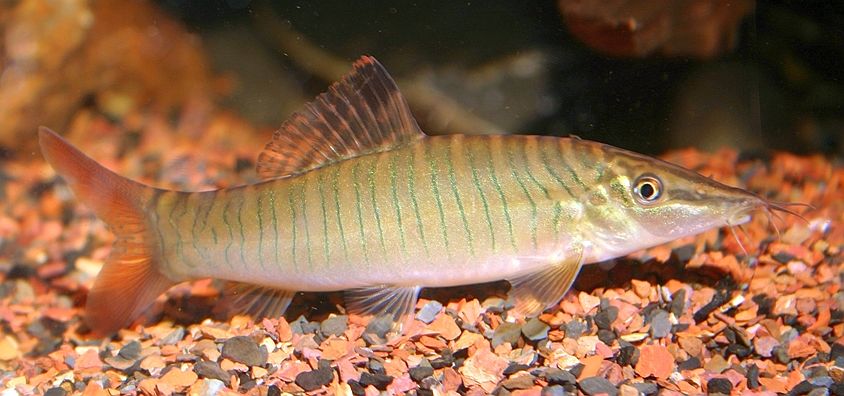The Tiger Botia Loach (Syncrossus hymenophysa) is also commonly called the Green Tiger Loach, Banded Loach, Green Tiger Botia, Tiger Botia or Zebra Loach and is highly prized by tropical fish keeping enthusiasts for their beauty, rarity, and scavenging ability.
The Tiger Botia Loach is found in the Musi River basin, South Sumatra province, Sumatra, Indonesia, the Malaysian state of Sarawak, and the Indonesian province West Kalimantan, on Borneo. It has also been reported in the Pahang and Perak river system in Malaysia and in Java.
It has an elongated body with a conical pointed head. Its mouth faces downward and like other Botias has three pairs of barbels protruding from its mouth area. It has a forked erectile spine below its eye that is about as long as the diameter of the eye. The upper part of its body is brownish or yellowish brown, and the underparts are pale yellow. Its grayish yellow or gray-green flank is marked with 11 or more dark brown to black transverse bars (stripes), which are positioned slightly obliquely and give the fish its “Tiger” appearance. The bars are separated by narrow pale areas that do not reach the belly. Its fins are yellowish or greenish, and there are thin dark bands on its dorsal and caudal fins.
The Tiger Botia Loach grows quite large (10″ in length), is semi aggressive, but enjoys the company of others of its own size, age, and species. It is a shoaling fish that should be kept in groups of 5 or more in a tank of at least 55 gallon capacity.
Tiger Botia Loaches are active carnivorous scavengers but they are shy and need caves, holes, bogwood roots and other places to hide, especially when sleeping. They are active burrowers and need a sand or very fine gravel substrate in their aquarium which should be densely planted (with potted plants) and heavily aquascaped with smooth river rock and driftwood
.
In their natural habitat, Tiger Loaches are found in small, upland, headwater streams to main river channels and lakes. They are tolerant of water parameters but require soft clean water with a moderate current. A 25-30% monthly water change should be considered routine maintenance for this species.
In addition to being natural predators of snails, Tiger Botia Loaches will voraciously eat insect larvae, small or chopped worms, frozen or freeze dried bloodworms, tubifex, brine shrimp
, ghost shrimp
and flake or carnivore pellets. They are grazers and should be fed small portions several times a day.
The breeding habits of this species is still not known, and successful captive breeding have not been recorded.
Tiger Botias are usually 1-3/4″ to 2-1/2″ long when offered for sale.
Minimum Tank Size: 55 gallons
Care Level: Moderate
Temperament: Semi-aggressive
Aquarium Hardiness: Hardy
Water Conditions: 72-86° F, KH 8-12, pH 6.0-7.0, dH: <12 degrees.
Max Size: 10″
Color Form: Black, Green, Tan, White
Diet: Omnivore
Compatibility: Not suitable for peaceful community tanks
Origin: Asia
Family: Cobitidae
Life Span: 7 Years
Aquarist Experience Level: Intermediate




